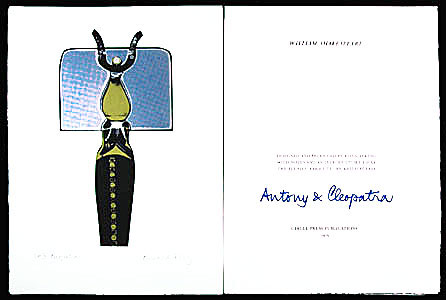
Antony & Cleopatra
By William Shakespeare.
Guildford, England: 1979. Edition of 300 + 40 proofs.
40 x 32cm. Designed and produced by Ronald King with notes & introductory essay 'The Elusive Absolute' by Keith Please. Text in 10 pt Baskerville. Paper is pure rag-made 250 gsm. Velin Cuve Rives Blanc. 11 eight-page unstitched sections contained in a specially designed canvas cover portfolio. Production involved over 200 hand printings. In beige & blue folding box designed by Paul Haskell.
A beautifully rendered edition of Shakespeare's play with King's own marginal notes and lustrous contemporary illustrations.
Cooking the Books: "Antony & Cleopatra is a departure from King's other illustrated classic texts. He himself likens it to a contemporary film script in that it flits from place to place, the scene rapidly changing from Rome to Egypt and back again. Something of this hectic quality permeates King's imagery. Here is the dangerous red of a stag party to convey Pompey's Roman galley scene, there the crap game through which Antony stands to lose so much. Elsewhere is the Shirt of Nessus, arising out of King's research in Plutarch and other sources, used here in allusion to death, murder, and suicide. The book's presiding mood is flux, the outcome catastrophe.
"Instead of the mask designs which had distinguished The Prologue and Macbeth, King introduced the shapes of kites into this particular text. Some variant masks still appear – the 'portraits' of Cleopatra, for example, or of Caesar – but the visual drama is mostly provided by kites. On the first double-page, a spear-shaped kite cut-out is glued down over loose ends of rough string protruding from either side. A frieze of writing runs along the bottom of both pages. The next image evokes a soothsayer, with images of palmistry and the zodiac. Two intertwining sinuous lines, one brown and one blue, stand for the respective rivers of Rome and Egypt, the Tiber and the Nile. Later in Act IV at the beginning of Scene 3, what looks like a box kite dangles its ribbons across several lines of text.
"The blue textual notes in King's handwriting enhance the film-script look of these pages. The writing is a commentary on the play by Keith Please …, often in the apparent form of marginalia, like the annotations on a 17th-century manuscript, footnotes as it were to the smallish letterpress text …"
$2,400 (Last Copy)